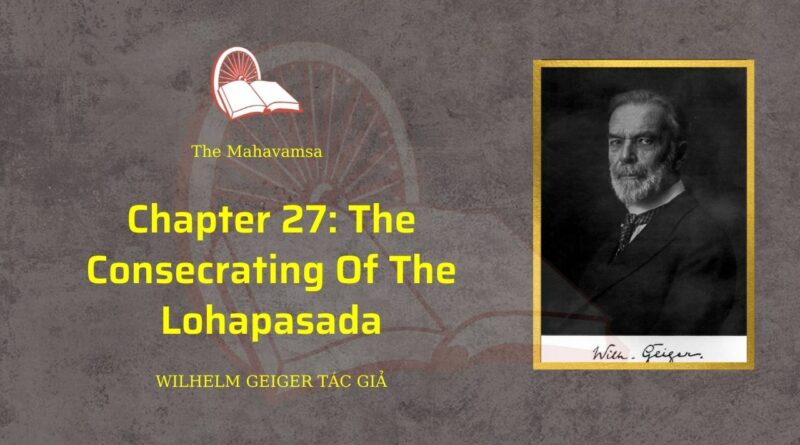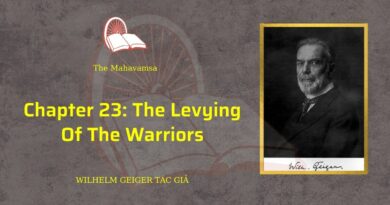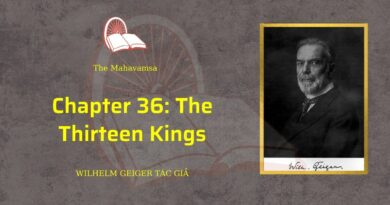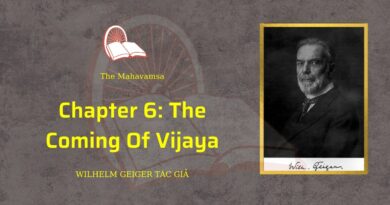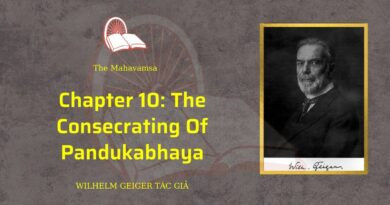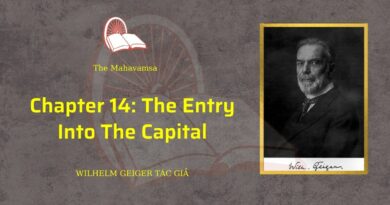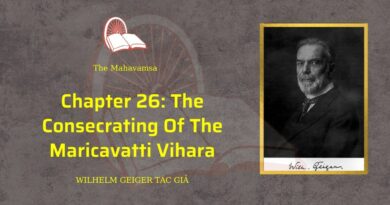THE MAHAVAMSA – CHAPTER 27: THE CONSECRATING OF THE LOHAPASADA
HEREUPON the king called to mind the tradition known to all, and duly handed down: ‘The thera rich in merit, ever intent on meritorious works, who formed his resolves in wisdom, who converted the island did, as is known, speak thus to the king, my ancestor: “Thy descendant, the king Dutthagamani, the wise, will hereafter found the Great Thüpa, the splendid Sonnamali a hundred and twenty cubits in height, and an uposatha-house, moreover, adorned with manifold gems, making it nine stories high, namely the Lohapasada.”
Thus thought the ruler of the land, and finding, when he made search, a gold plate kept in a chest and laid by in the palace with such a written record thereon, he commanded that the inscription be read aloud: ‘When one hundred and thirty-six years have run their course, in future time will Kakavanna’s son, the ruler of men, Dutthagamani, build this and that in such and such wise.’ When the king had heard this read he uttered a cry of joy and clapped his hands. Then early in the morning he went to the beautiful Mahamegha-park, and when he had arranged a gathering together of the brotherhood of the bhikkhus he said to them: ‘I will build for you a pasada like to a palace of the gods. Send to a celestial palace’ and make me a drawing of it.’ The brotherhood of the bhikkhus sent thither eight (theras) who had overcome the asavas.
In the time of the sage Kassapa a brahman named Asoka, who bad set out eight ticket-meals (to be apportioned) to the brethren, commanded his serving-woman named Birani:
‘Give of this continually.’ When she had given these gifts faithfully her whole life long she left this (world) and was reborn as a lovely maiden in a gleaming palace, floating in the air, (and she was) continually served by a thousand nymphs. Her gem-palace was twelve yojanas high and measured forty-eight yojanas round about; it was adorned with a thousand jutting window-chambers, nine-storied and provided with a thousand chambers, gleaming with light, four-sided, with a thousand shell-garlands and with windows as eyes and provided with a vedikä (adorned) with a network of little bells. In the middle of the (building) was the beautiful Ambalatthika-pasada, visible from every side, bright with pennons hung out. When the theras, going to the heaven of the thirty-three (gods), saw that (palace) they made a drawing of it with red arsenic upon a linen cloth, and they returned, and being arrived they showed the linen to the brotherhood. The brotherhood took the linen and sent it to the king. When the king full of joy saw it he went to the splendid Aräma and caused the noble Lohapasada to be built after the drawing.
At the time that the work was begun the generous (king) commanded that eight hundred thousand gold pieces should be placed at each of the four gates; moreover, at each gate he commanded them to lay a thousand bundles of garments and many pitchers filled with ball-sugar, oil, sugar-dust, and honey, and proclaiming, ‘No work is to be done here without reward,’ he had the work done (by the people) appraised, and their wage given to them.
The pasada was four-sided, (measuring) on each side a hundred cubits, and even so much in height. In this most beautiful of palaces there were nine stories, and in each story a hundred window-chambers. All the chambers were overlaid with silver and their coral vedikas were adorned with manifold precious stones, gay with various gems were the lotusflowers on the (vedikas) and they (the vedikas) were surrounded with rows of little silver bells.
A thousand well-arranged chambers were in the pasada, overlaid with various gems and adorned with windows. And since he heard of Vessavana’s chariot which served as a car for the women, he bad a gem-pavilion set up in the middle (of the palace) fashioned in like manner. It was adorned with pillars consisting of precious stones, on which were figures of lions, tigers, and so forth, and shapes of devaths; a bordering of pearl network ran round the edge of the pavilion and thereon was a coral vedikä of the kind that has been described above.
Within the pavilion, gaily adorned with the seven gems, stood a shining beauteous throne of ivory with a seat of mountain-crystal, and in the ivory back (was fashioned) a sun in gold, a moon in silver, and stars in pearls, and lotus-blossoms made of various gems were fitly placed here and there and Jataka-tales in the same place’ within a festoon of gold.
On the exceedingly beautiful throne covered with costly cushions was placed a beautiful fan of ivory, gleaming (magnificently), and a white parasol with a coral foot, resting on mountain-crystal and having a silver staff, shone forth over the throne. On it, depicted in the seven gems, were the eight auspicious figures and rows of figures of beasts with jewels and pearls in between; and rows of little silver bells were hung upon the edge of the parasol. Palace, parasol, throne, and pavilion were beyond price.
Costly beds and chairs, according to rank, and carpets and coverlets of great price did he command them to spread about. The rinsing-vessel and the ladle (belonging thereto) were even of gold; what need then to speak of the other utensils in the palace? Surrounded by a beautiful enclosure and provided with four gateways the pasada gleamed in its magnificence like the ball in the heaven of the thirty-three (gods). The pasada was covered over with plates of copper, and thence came its name ‘Brazen palace’.
When the Lohapasada was ready the king assembled the brotherhood, and the brotherhood came together as at the consecration-festival of the Maricavatti (vihara). Those bhikkhus who were yet simple folk stood on the first story, those learned in the tipitaka on the second, but those who had entered on the path of salvation and the others (stood) each on one of the third and higher stories,’ but the arahants stood on those four stories that were highest of alL
When the king had bestowed the pasada on the brotherhood, after pouring forth the (ceremonial) water of presentation, he commanded, as before, a lavish gift of alms for a week. That which was spent by the generous king for the pasada, leaving aside all that which was beyond price, is reckoned at thirty kotis.
The wise who consider how marvellously precious is the giving of alms, while the gathering together of treasures (for oneself) is worthless, give alms lavishly, with a mind freed from the fetters (of lust), mindful of the good of beings.

